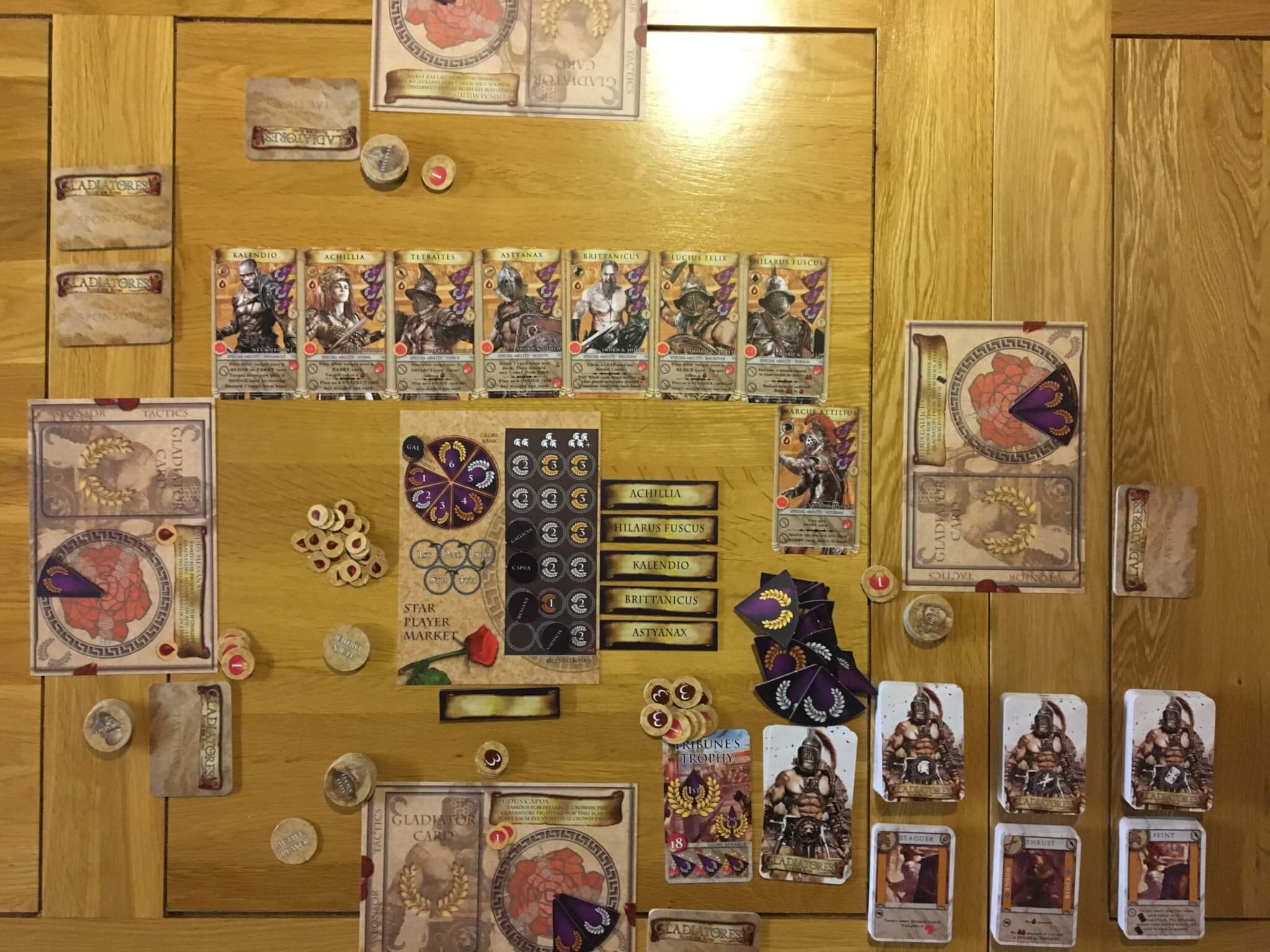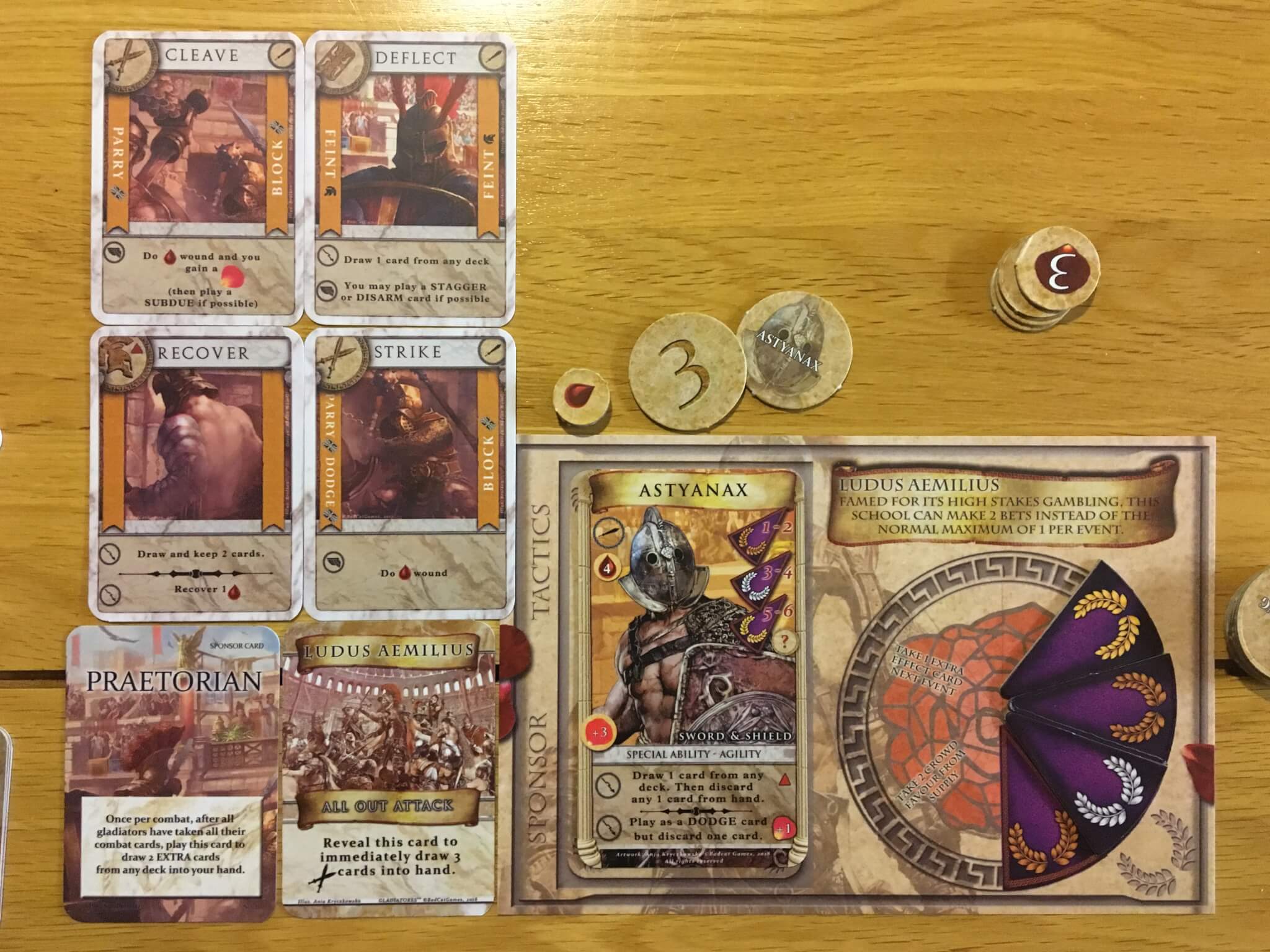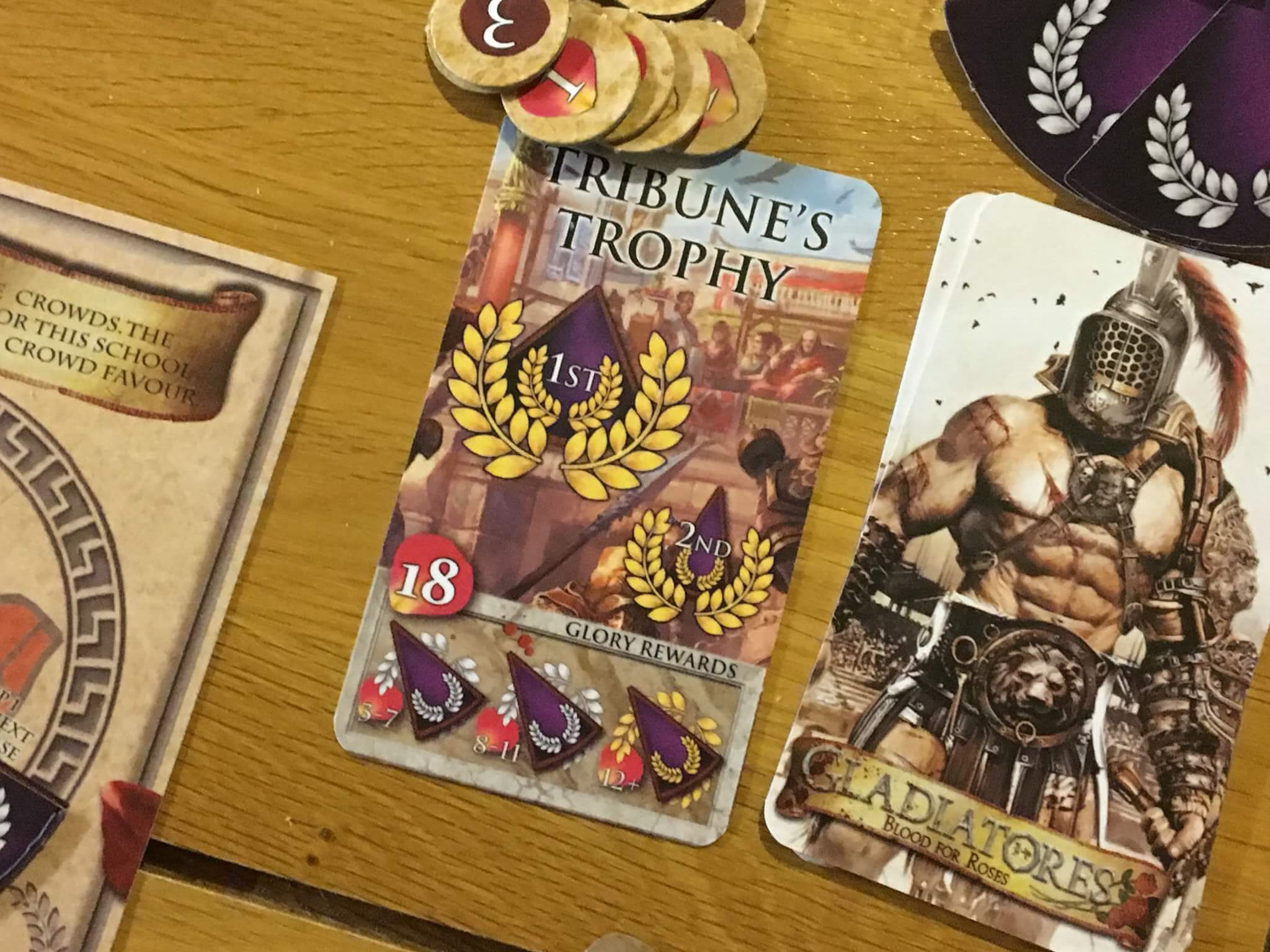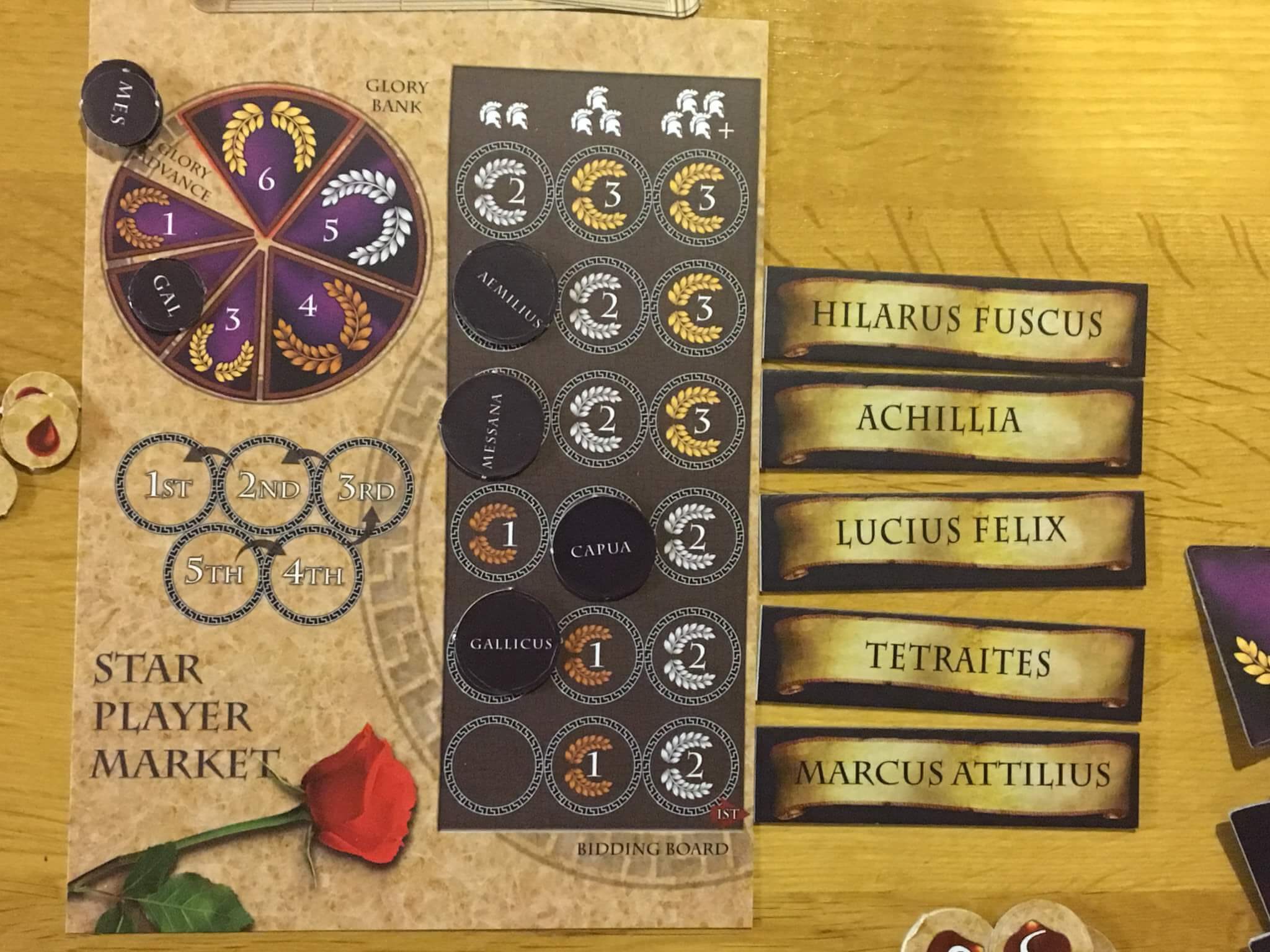Gladiatores: Blood for Roses — Am I not merciful?
Gladiatores: Blood for Roses is a feature-packed card game that has two to five players competing as gladiatorial schools that must bid for the best fighters, bet on combat in the arena and ultimately, participate in duels to the death.
Upon first reading, you’d be forgiven for thinking that these very different kinds of gameplay mechanic would make Gladiatores: Blood for Roses a hugely convoluted game. This is not helped by the initial setup, which is pretty vast (albeit well explained thanks to a separate insert that details everything aspect clearly.) Fear not, though, because just as you might be hoping, this game about bloodthirsty arena combat is actually a lot more straightforward than it appears.
Gladiatores: Blood for Roses actually has so many moving parts that I hardly know where to start, so as such, the only logical place is right at the beginning. Players begin by choosing a school, each of which comes with its own benefit — such as generating more crowd favour, being better at attacking or defending or making their own gladiators tougher. Each school has its own deck of tactics cards too, but I’ll explain them later. The players will then set up the initial bidding phase.

Without explaining this in finite detail, the players will draw tokens for a number of gladiators equal to the number of players plus one, assigning them in turn to the bidding spaces on a central board. The higher up the board a gladiator is, the more costly they will be to bid for. Gladiatores uses a bronze, silver and gold wreath system (that represents glory) in bidding and the lowest bid for each gladiator is shown on the board.
I’ll level my first criticism here, which is that the bidding system is unnecessarily complex — there’s no need for a board or a minimum bid as far as I can tell, so I’d much prefer a system where the first player (in order) simply declares a bid and then the other players each decide if they wish to outbid them until all but one player passes. No matter what, everyone ends up with a gladiator, since there is always one more than there are players. Maybe there’s a reason, but I can’t fathom it — in any case, Gladiatores: Blood for Roses requires a bit of learning, but it won’t take more than five minutes.
After bidding, players each take their gladiator and place it in their school. They then take the unique set of combat cards associated with that gladiator and (in the base variant) draw five more cards from the attack, defence and effect decks in any way they wish. Crowd favour and hit point tokens are then taken according to the stats of their gladiator and the event is setup. This last step is simply a case of flipping over an event card to see how much glory and fan support is at stake in the next set of games.

The final act before the grizzly combat begins is betting. Each player has a stack of tokens (one for each gladiator) and they now have the chance to place a bet on one of them. The various gladiator will score a different amount of glory depending on where they place in the competition and it’s worth noting that there’s no need to bet on your own gladiator. It’s simply a case of either doubling down on your own guy or hedging your bets and backing two horses.
Now, I know that I promised that we’d be getting into the combat soon, but we still need to discuss sponsor cards and tactics. A sponsor card can be placed face down at the beginning of the round, and will, at some point, confer a bonus to the school when played. The players will each have one sponsor card (chosen from a pair earlier) so everyone gets a bonus of some kind or another.

Gladiator schools each come with their own set of tactics, and as with sponsors, one tactic card will be chosen at the beginning of each event. The sponsor cards tend to offer a powerful single use effect, whereas tactics tend to dictate the style or focus for that particular school during the entire event. Most tactics add another layer of personality to each school and alongside the specific ability of that school, ensure differentiation between schools during the event itself.
When battle is joined, the players take it in turns to attack one another, with all combat being one on one between two gladiators. The attacking player must declare who they are attacking and then play an attack card to the table. Each card has a specific effect if resolved, as well as one or two cards listed on the flanks that can counter it. Usually, at this point, the player being attacked will play one of those cards in response.
Combat continues in this way, with players trading blows, parry’s, shoves, throws and so on until someone either cannot respond or chooses not to. Whichever card is on the top of the pile when this exchange ends will be resolved. This might result in a hit point deduction or possibly the need to discard at least one card. To make matters slightly more confusing, each gladiator has a special ability which is usually affect combat, as can some tactics, so there’s a lot to keep an eye on.

A key complication to this structure comes from the fact that when a gladiator runs out of cards, they will simply collapse from exhaustion — meaning that they are out of the contest. As a result of this, it can sometimes be worth taking a minor hit or the effect of one of the less damaging cards, simply to ensure that you use less of your own more powerful cards and can save them for later. In fact, this is one of the key decisions in Gladiatores: Blood for Roses.
The fight continues until only one gladiator remains, but one thing to note is that the way players react to these rules is interesting to say the least. In a multiplayer game, I’ve noticed that some players felt somewhat disadvantaged by being the first player to be attacked. This was the result of some folk being attacked by one player and then another because they were seen as a weaker target. The same can kind of be said for the first attacker too, although the consensus is that the first attacker will still have most of his defensive cards (but fewer overall.)

There’s no real way that I have found to mitigate this, although one method that we tried was to have the players sat opposite each other fight each other in turn in the first engagements and then allow combat to follow the normal rules. We also toyed with the idea of allowing later players to draw extra cards, but since the player order is not linked to the order of who is attacked when, that doesn’t fix it either. On balance, it’s not a major problem, but it legitimately can mean that a gladiator in fourth or fifth turn order can be killed long before they have a chance to attack.
The event ends when only one gladiator is left standing, either as the result of the other players having all their hit points taken,or the other gladiators collapse from exhaustion. At this point, the first and second placed players claim glory based on the event details and any remaining crowd favour is shared out. The winner is the player who can fill out the glory wheel on their player board over as many events as it takes to do so. Gladiatores: Blood for Roses also has a short version which is essentially just a single event and in two player mode, you can skip betting, bidding etc.
Overall, I find Gladiatores: Blood for Roses to be a satisfying and exhilarating experience that simulates the blow by blow combat of the era remarkably well. The copy we have received is an early preview, but much of the artwork (a lot of which is from Gloom of Kilforth artist Ania Kryczkowska) is of a very high standard and looks final to me. Some of the combat cards are a bit generic compared to the superbly characterful gladiators, but that’s OK.

The downsides are more or less as I’ve mentioned already. You’ll need to be prepared to put up with some complaints about the outcome of combat, depending on how your group behaves, and you may find a more efficient method of conducting the bidding, but the latter point is minor. I’m also not convinced that I completely understand the currency system even now. There are small and large wreaths in bronze, silver and gold and it’s a bit confusing to understand how the size, colour and printed value of these tokens relates.
Despite some slight issues, the uniqueness of each gladiator (thanks to the card text and imagery, the tactics, sponsors and school abilities) is strong and it comes across in the decks and the way the gladiators fight. I might have endorsed even more uniqueness, but as things stand, Gladiatores: Blood for Roses feels as though it strikes the right balance between asymmetry and balance — which is great. As an unusual addition to your collection, I rate Gladiatores: Blood for Roses very highly, but clearly, it will appeal to fans of hand management, card combat and the fairly brutal subject matter more than it will fans of less visceral experiences.
Gladiatores: Blood for Roses will be available soon, with this article being written from a late stage preview build. You can find out more about it by visiting Badcat Games.
Love board games? Check out our list of the top board games we’ve reviewed.

Comments are closed.